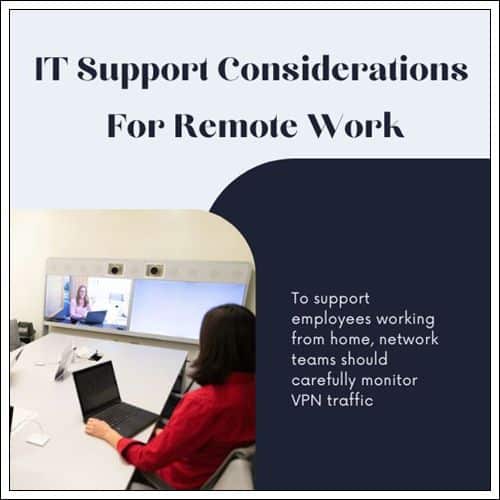
While most individuals like the flexibility and ease of working remotely, having to fix technical difficulties on their own can be scary for nontech personnel.
When working in the office, a tech problem is most of the time quickly fixed by calling the in-house information technology (IT) section. This is done by asking them to send someone out to the office to address the issue. However, when a nontech-savvy professional is at home alone with a broken computer or malfunctioning software, trying to diagnose and fix the problem on their own or simply trying to describe what they’re seeing over the phone can be bothersome, to put it nicely.
The success of remote work arrangements is desired by both the organizations and the team members. To make that happen, management must make sure there’s a sound remote IT support structure in place to assist staff in maintaining their technological equipment. This is to not only reduce annoyance yet also to stop wasting money and losing productivity.
Below are some essential IT support considerations for your remote team. Keep on reading to learn more.
1. 24/7 IT Support

Some team members may need to change to atypical work schedules as a result of remote operations, which is to be expected. When the system fails or a remote worker can’t access the data, they may require immediate help. Ensure they can get in touch with the IT personnel at any moment to give your staff the best IT assistance possible.
A remote workforce needs IT support that’s accessible around the clock, every day of the week. Depending on their time zone, remote workers may have varying needs that must be met at all times. Your staff won’t have to waste time waiting when problems are quickly resolved; instead, they can go back to work on their tasks. Consider contracting services to a qualified IT support firm if you’re unable to create an internal 24/7 IT crew.
2. Emergency Response Team

The majority of tech-related problems may be fixed remotely, but occasionally it may be necessary to look at a worker’s hardware. It’s possible that your employee won’t be able to get to the office to turn in their gadgets, given the circumstances. Working with a local managed IT service provider is the best course of action. They may offer services that include responding to emergency hardware failures and damages.
A local managed service provider (MSP) with a vast network of IT support should be hired. With the help of this system, the MSP can dispatch a technician to one of your remote employees’ locations, who can immediately fix the devices. A well-designed system created by the service provider will guarantee a more productive workflow among your team.
3. Security Protocols

Working from home isn’t the only option while working remotely. Even if it might be the most typical situation, some of your employees might prefer a more comfortable place where they can work more efficiently. Fast internet connectivity is now readily available in places such as work cafes, libraries, and coffee shops, thanks to technological advancements. Unfortunately, your company’s systems are at risk in these locations.
In terms of data security and cybercrime, businesses that manage sensitive data, such as financial data or confidential patient records, might find themselves in a difficult situation. Therefore, your IT staff must adhere strictly to cybersecurity best practices for remote teams.
Important measures to guarantee that employees can operate remotely safely include compulsory two-factor authentication, restricted access to important directories and files, setting up a VPN (virtual private network), and installing antivirus, spam filtering, and malware protection software, among others.
4. Hardware And Software Provisions
Many organizations are unaware that most employees are working with their personal devices and that some employees may be lacking the necessary equipment to work remotely.
The finest equipment is always company-owned, and it should be provided to employees since it allows for tighter security control and provides easier accessibility whenever users seek support. Information about your firm is at risk as well if the majority of your remote workers use their own gadgets. Establishing a Master Data Management (MDM) Policy can aid in safeguarding your company and its sensitive data if your team members use their personal devices. It guarantees that inventories, security, and software are managed effectively.
Inquire about your employees’ internet connectivity levels. Demand faster speeds, data plans, or hotspots, and be ready to pay for them. Better productivity is a result of having quality internet service, particularly if workers are sending, receiving, and sharing huge document files. Make sure your staff has enough bandwidth if you want them to use the internet and teleconferencing tools.
5. The Cloud
One way many firms struggle to guarantee their personnel has a seamless experience while working from home is by failing to adopt the appropriate cloud-based corporate services. Placing your corporation on the cloud can boost overall security and workplace productivity. Cost reductions, disaster recovery, backups, and accessibility to your data and applications from any location are other advantages of the cloud.
6. Employee Training
When attempting to fix problems for both on-premise and remote workers, IT staff might sometimes find themselves overworked. IT managers can educate remote workers to address common issues on their own by building a self-help system and using the appropriate engagement and automation tools.
For minimal, frequent issues, this can entail developing troubleshooting guidelines, creating a FAQ pdf, or encouraging remote personnel to submit IT concerns with specific details so they can be fixed more quickly. Giving your nontechnical remote staff a ‘cheat sheet’ is another simple tactic to help them hone their self-service technical abilities. Provide new hires who’d like to master how to utilize the tools and applications they’ll be operating every day, with simple virtual lessons as well. Ensure all new hires have access to this resource. Your team will become more efficient with this strategy.
Training can also help reinforce security measures by making sure employees are informed of the different attack types, how they should respond, as well as how their actions could impact the organization. The digital space evolves rapidly, calling for continuous security training for remote workers.
Conclusion
The practice of working remotely for many more workers has now become the norm. Businesses must, nonetheless, offer the IT support that remote workers need to remain productive. Employ the suggestions outlined in this article to provide your staff with remote IT support and to boost your company’s efficiency.
Leave a Reply
You must be logged in to post a comment.